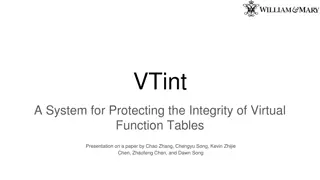
Innovative Insights on Racial Segregation Trends in America
Discover intriguing research insights on the decreasing racial segregation in urban areas, implications for survey sampling strategies, and the importance of accurate representation in minority population studies. Explore the nuances of geographic-based oversampling and the effectiveness of screening methods in data collection.
Download Presentation

Please find below an Image/Link to download the presentation.
The content on the website is provided AS IS for your information and personal use only. It may not be sold, licensed, or shared on other websites without obtaining consent from the author. If you encounter any issues during the download, it is possible that the publisher has removed the file from their server.
You are allowed to download the files provided on this website for personal or commercial use, subject to the condition that they are used lawfully. All files are the property of their respective owners.
The content on the website is provided AS IS for your information and personal use only. It may not be sold, licensed, or shared on other websites without obtaining consent from the author.
E N D
Presentation Transcript
Discussion of Chen and Kalton David R. Judkins Abt Associates WSS December 3, 2014 Abt Associates
Notes America is becoming less racially segregated At least in urban areas Hooray! Different story than the WSS presentation Joe Waksberg gave on the topic on March 18, 1992 (only time I ever made the A section of the Washington Post) But bad news for low-cost oversampling of minorities for surveys Need to rely more on screening Abt Associates 2
Limits of inexpensive minority samples Some list purveyors draw your attention to low false positive rates when all that matters are the false negative rates These they hide or do not even understand Don t accept a sample of rural and ghetto blacks as representative of the national experience for African Americans Same is true for reservation-based sample of the American Indian and Alaskan Native population Abt Associates 3
Geographic-based oversampling Still makes sense for one-off surveys Particularly of AIAN populations and rural nonwhite populations Avoid for longitudinal surveys and surveys with expensive add-on elements such as laboratory work Makes sense perhaps for very large surveys in combination with screening even if return is very small, but need to consider fixed cost of systems to implement it Abt Associates 4
Screening Much easier to target multiple rare domains Does not lead to large design effects for majority population as does oversampling without screening However, field staff do not like it They need to train interviewers for two very different tasks Effort to get the foot in the door is so high that they hate to walk away from a cooperative respondent Counter with liberal use of proxies for screening (neighbors) Remember though to allow for screening errors in projecting design effects Abt Associates 5
Some additional references Wright, D., Judkins, D., and Ryaboy, S. (1992). Residential segregation and health of minority populations. Proceedings of the Social Statistics Section of the American Statistical Association, pp. 198-203. Fahimi, M., and Judkins, D. (1991). PSU probabilities given differential sampling at second stage. Proceedings of the Section on Survey Research Methods of the American Statistical Association, pp. 538-543. Abt Associates 6
Contact Information David_Judkins@abtassoc.com Abt Associates





















